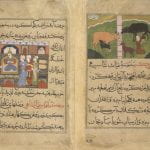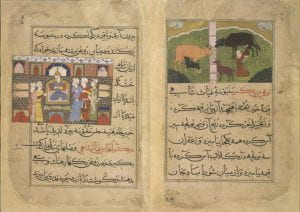When my mother first met my dad’s parents, one of the first Indian dishes my grandmother started her with was kheer. Whenever my brothers and I visited in the summers, she would always have some prepared for my arrival and right after I hugged her at the door I shot off to the fridge!
Cooking the rice in milk with cardamom pods
Kheer is believed to have originated in the Lord Jagannath Temple in Orissa almost 2,000 years ago. Traditionally, it was served as a special offering to the Hindu gods. The practice of offering kheer spread to all corners of the South Asia region to a multitude of Hindu temples—the exact recipe was altered a bit depending on local traditions and tastes. Currently, there are significant differences in kheer from Southern, Eastern, and Northern India.[1]
A page from Nimmatnama-i-Nasiruddin-Shahi which documents the fine art of making kheer. Credit Wikipedia
In Southern India, this rice dish is known by its Hindi name, payasam, and due to an ancient legend, it is served at temples as part of a treasured tradition. The story originates from the Ambalappuzha temple and describes how Lord Krishan cleverly disguised himself as an old sage and challenged a local king to a chess match. The king accepted the offer and for the bet, the king would owe a grain of rice for each square of the chessboard, but with one catch—each subsequent square would have double the grains of the previous. The sage wins and the king realizes his mistake as he owes trillions of grains of rice. Krishna reveals himself and instead of forcing payment he institutes a tradition that at the local temple, kheer shall be served freely to anyone who entered.[2]
Kheer was also one of the most popular dishes with the British once they began settling and ruling India. Once wives began coming from England, Anglo-Indian cookbooks began to be produced and shared.
These Anglo-Indian cookbooks, which were printed often, brought what might be considered “modern” recipe standard to Indian kitchens. They weren’t just cookbooks but also management guides for homes that were intended to help the British women arriving in India adjust to this new context. During the 19th century, these cookbooks would define and continually redefine the methods of how British families and houses in India worked and what they ate. With the expansion of the colonial rule and deepening racial divide after 1857, many households stopped eating local food and stuck primarily to British cuisine. However, kheer was still consumed though it was co-opted by the British and appropriated.
Kheer, a kind of rice pudding, is a simple dish that can be easily customized with spices and toppings. Traditionally, cardamom is the primary spice used for the desert. Saffron is also often used, but not as the primary flavor profile. For toppings, different kinds of raw nuts and dried fruits are added like cashews or almonds and raisins or mangoes. However, most of the rice pudding available in grocery stores and major commercial outlets are not kheer. They do not contain cardamom nor are they prepared in the same way—cinnamon is often used instead. The beauty of personalization also extends to servings methods with kheer. It can be served hot right after cooking or chilled and eaten cold. Kheer is a perfect base or canvas to express a host of diverse, culinary tastes and ideas.
This dish was so much fun to make and it made my dad so happy when I surprised him with his mother’s famous kheer. It also deepened my understanding of the appreciation and versatile, expert use of milk in Indian cuisine. With one ingredient, there are so many wonderful possibilities! Uncovering the history of kheer also deepened my understanding of Indian history and how significant a role food plays. The first mention of kheer, which historians say was derived from the Sanksrit word kshirika (meaning a dish prepared with milk), is found in the fourteenth century Padmavat of Gugarat. Its origins are tied to temples and religious legends, demonstrating just how tied religion, history, and food are for India.
[1] SEMIYA PAYASAM. (n.d.). Retrieved June 24, 2020, from http://www.vahrehvah.com/indianfood/semiya-payasam/
[2] History of Indian Food. (n.d.). History of Indian Food. Retrieved June 24, 2020, from http://www.haldiramusa.com/History_Indian_Food.htm




